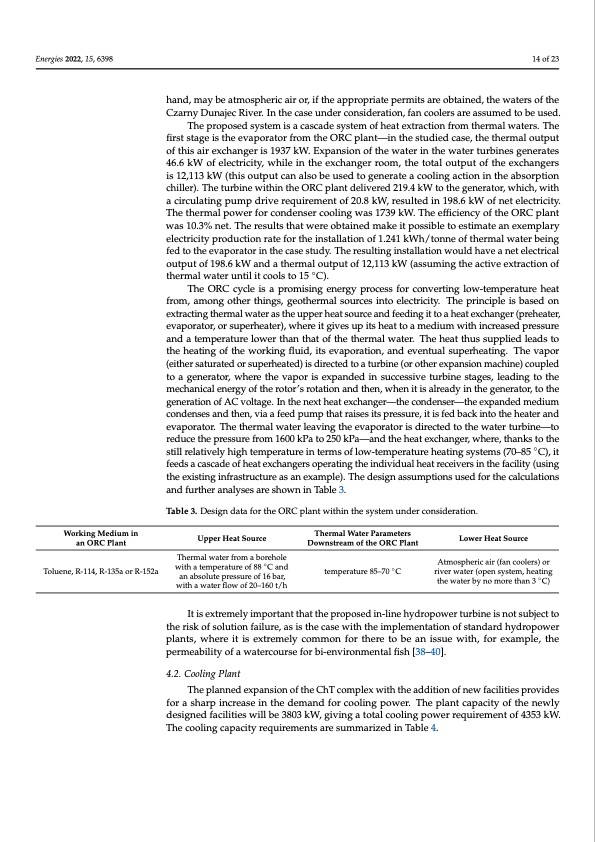
PDF Publication Title:
Text from PDF Page: 014
Energies 2022, 15, 6398 14 of 23 Working Medium in an ORC Plant Toluene, R-114, R-135a or R-152a Upper Heat Source Thermal water from a borehole with a temperature of 88 ◦C and an absolute pressure of 16 bar, with a water flow of 20–160 t/h Thermal Water Parameters Downstream of the ORC Plant temperature 85–70 ◦C Lower Heat Source Atmospheric air (fan coolers) or river water (open system, heating the water by no more than 3 ◦C) hand, may be atmospheric air or, if the appropriate permits are obtained, the waters of the Czarny Dunajec River. In the case under consideration, fan coolers are assumed to be used. The proposed system is a cascade system of heat extraction from thermal waters. The first stage is the evaporator from the ORC plant—in the studied case, the thermal output of this air exchanger is 1937 kW. Expansion of the water in the water turbines generates 46.6 kW of electricity, while in the exchanger room, the total output of the exchangers is 12,113 kW (this output can also be used to generate a cooling action in the absorption chiller). The turbine within the ORC plant delivered 219.4 kW to the generator, which, with a circulating pump drive requirement of 20.8 kW, resulted in 198.6 kW of net electricity. The thermal power for condenser cooling was 1739 kW. The efficiency of the ORC plant was 10.3% net. The results that were obtained make it possible to estimate an exemplary electricity production rate for the installation of 1.241 kWh/tonne of thermal water being fed to the evaporator in the case study. The resulting installation would have a net electrical output of 198.6 kW and a thermal output of 12,113 kW (assuming the active extraction of thermal water until it cools to 15 ◦C). The ORC cycle is a promising energy process for converting low-temperature heat from, among other things, geothermal sources into electricity. The principle is based on extracting thermal water as the upper heat source and feeding it to a heat exchanger (preheater, evaporator, or superheater), where it gives up its heat to a medium with increased pressure and a temperature lower than that of the thermal water. The heat thus supplied leads to the heating of the working fluid, its evaporation, and eventual superheating. The vapor (either saturated or superheated) is directed to a turbine (or other expansion machine) coupled to a generator, where the vapor is expanded in successive turbine stages, leading to the mechanical energy of the rotor’s rotation and then, when it is already in the generator, to the generation of AC voltage. In the next heat exchanger—the condenser—the expanded medium condenses and then, via a feed pump that raises its pressure, it is fed back into the heater and evaporator. The thermal water leaving the evaporator is directed to the water turbine—to reduce the pressure from 1600 kPa to 250 kPa—and the heat exchanger, where, thanks to the still relatively high temperature in terms of low-temperature heating systems (70–85 ◦C), it feeds a cascade of heat exchangers operating the individual heat receivers in the facility (using the existing infrastructure as an example). The design assumptions used for the calculations and further analyses are shown in Table 3. Table 3. Design data for the ORC plant within the system under consideration. It is extremely important that the proposed in-line hydropower turbine is not subject to the risk of solution failure, as is the case with the implementation of standard hydropower plants, where it is extremely common for there to be an issue with, for example, the permeability of a watercourse for bi-environmental fish [38–40]. 4.2. Cooling Plant The planned expansion of the ChT complex with the addition of new facilities provides for a sharp increase in the demand for cooling power. The plant capacity of the newly designed facilities will be 3803 kW, giving a total cooling power requirement of 4353 kW. The cooling capacity requirements are summarized in Table 4.PDF Image | Combined Renewable Energy Resources System Geothermal

PDF Search Title:
Combined Renewable Energy Resources System GeothermalOriginal File Name Searched:
energies-15-06398.pdfDIY PDF Search: Google It | Yahoo | Bing
Turbine and System Plans CAD CAM: Special for this month, any plans are $10,000 for complete Cad/Cam blueprints. License is for one build. Try before you buy a production license. More Info
Waste Heat Power Technology: Organic Rankine Cycle uses waste heat to make electricity, shaft horsepower and cooling. More Info
All Turbine and System Products: Infinity Turbine ORD systems, turbine generator sets, build plans and more to use your waste heat from 30C to 100C. More Info
CO2 Phase Change Demonstrator: CO2 goes supercritical at 30 C. This is a experimental platform which you can use to demonstrate phase change with low heat. Includes integration area for small CO2 turbine, static generator, and more. This can also be used for a GTL Gas to Liquids experimental platform. More Info
Introducing the Infinity Turbine Products Infinity Turbine develops and builds systems for making power from waste heat. It also is working on innovative strategies for storing, making, and deploying energy. More Info
Need Strategy? Use our Consulting and analyst services Infinity Turbine LLC is pleased to announce its consulting and analyst services. We have worked in the renewable energy industry as a researcher, developing sales and markets, along with may inventions and innovations. More Info
Made in USA with Global Energy Millennial Web Engine These pages were made with the Global Energy Web PDF Engine using Filemaker (Claris) software.
Sand Battery Sand and Paraffin for TES Thermo Energy Storage More Info
| CONTACT TEL: 608-238-6001 Email: greg@infinityturbine.com | RSS | AMP |